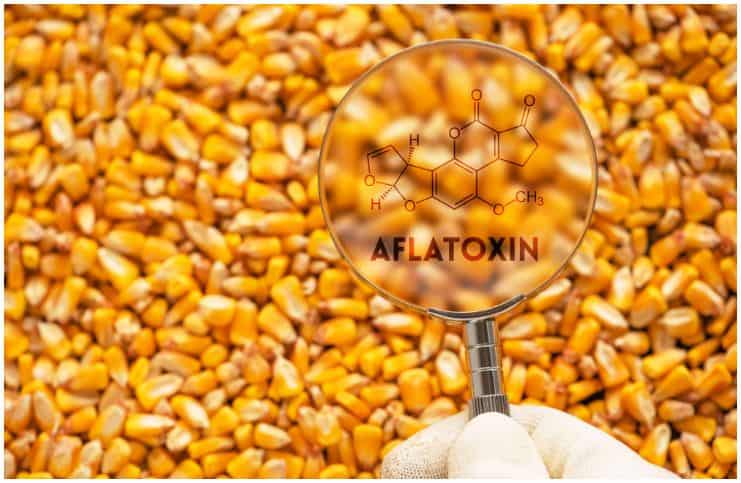Aflatoxin Poisoning:
Aflatoxin is a carcinogen and toxic substance produced by mold, that can infect food when it is stored in unsanitary conditions.
The microscopic fungi that produce aflatoxins grow on hazel, wheat, corn, beans, and rice crops, and it is a problem, especially in underdeveloped and developing countries.
It can also occur in animal products (fermented cheese, meat, eggs) due to the fact that animals are fed with contaminated fodder. In short, it is a natural mycotoxin produced by two types of mold: Aspergillus flavus and Aspergillus parasiticus.
Aspergillus flavus is common and widespread in nature and is most often found when certain grains are grown under harsh conditions, such as drought.
The mold occurs in soil due to the decomposition of vegetation, hay, and grain is in the process of microbiological deterioration, and invades all types of organic substrates whenever conditions are favorable for its growth.
Favorable conditions include high moisture (above 7%) and high temperature. This toxin can lead to liver cancer because the liver is the first place where most toxins accumulate.
The aflatoxins are soluble in a range of organic solvents, including:
- diethyl ether;
- petroleum ether;
- hexane;
- acetone (a colorless, volatile, flammable liquid with the formula (CH3)2CO);
- methanol (a chemical that is mainly produced industrially by hydrogenation of carbon monoxide);
- ethanol;
- chloroform (a colorless, dense liquid that is produced on a large scale as a precursor to PTFE; it has the chemical formula – CHCl₃).
The effects of this toxic substance were first discovered in England in 1960 when thousands of turkeys died within a few months. In humans, the researchers discovered that once a person consumes infected meat, the toxic substance can be passed on.
There Are Three Main Types:
Type B: This group includes aflatoxin B1 (the most common, toxic, and carcinogenic of all aflatoxins) and B2.
Type G: It includes aflatoxins G1 and G2.
Type M: It includes aflatoxin M1 and M2. These are metabolic products found in the urine and milk of animals that were fed with aflatoxin-contaminated fodder.
Health Impact Of Aflatoxin
People are exposed to aflatoxins by eating contaminated food. Unfortunately, such exposure is difficult to avoid because the growth of fungi in food is not easily preventable. Even if the heavily contaminated food supply is not allowed in developed countries, the concern regards the possible side effects resulting from long-term exposure to low levels of aflatoxins.
The syndrome includes vomiting, abdominal pain, pulmonary edema, convulsions and coma, and death by cerebral edema.
The medical term for aflatoxin poisoning is aflatoxicosis. This occurs after the consumption of food that is contaminated with mycotoxin aflatoxin. This condition is not contagious, and there are no medications that can help. The most affected organ is the liver.
US Food and Drug Administration (FDA) allows aflatoxins, at low levels, in nuts, seeds, and legumes because they are considered “unavoidable contaminants.” FDA believes that occasional eating small amounts of aflatoxins poses a low risk during one’s lifetime, and it is not practical to try a complete removal of aflatoxins in foodstuffs, in order to make them safer.
In order to reduce the risks, the FDA tests foods that may contain aflatoxins. Peanuts and peanut butter are some of the most rigorously tested products by the FDA because they frequently contain aflatoxins.
Aflatoxins are toxic to humans and even more toxic to animals. Researchers found that the lethal dose for animals is between 0.5 and 10 mg/kg body weight of the animal. As for foods that help reduce such toxicity, it is considered that vegetables such as carrots and celery can reduce the carcinogenic effects caused by aflatoxin.
How To Reduce The Intake
Do not store nuts and grains, especially corn, hazelnuts, and cottonseeds, for long periods of time (several months) before consuming!
Throwing foods that show signs of mouldiness. Removal of the part that contains mold is not enough.
Remember!
Once the food has been infected, it can not be eliminated through the boiling process, and the human body is not able to eliminate it.
It can be carcinogenic in certain circumstances and poses a risk, especially for pregnant women.
In Europe, the maximum permissible limit of aflatoxin is 0.05 parts/million/liter, compared to the maximum limit in the United States of 0.5 parts/million/liter.
READ THIS NEXT:
Black & Mild vs Cigarettes – Which Is Worse For Your Health?
Effects of Exposures to Cadmium
Calcium Propionate (E282) – Health Risks & Side Effects
References https://www.sciencedirect.com/topics/pharmacology-toxicology https://www.ncbi.nlm.nih.gov/pmc/articles/PMC5923302/

I ate a bag of Bitter tasting peanuts and now I am sick.
My head is swelled up.